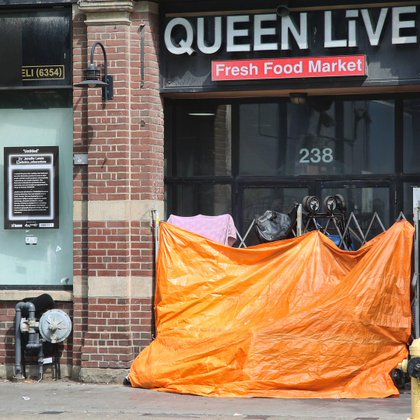
Karen Chapple
@profchapple
Followers
1K
Following
329
Media
20
Statuses
355
Director of School of Cities and Professor of Geography and Planning, U of Toronto, Professor Emerita UC Berkeley, Director of the Urban Displacement Project
Joined September 2010
We're on TikTok! Our new channel features short, interactive, digestible content for anyone who is passionate about city planning & sustainability or interested in the latest trends in urban life. Follow us at https://t.co/HYhDmMRBOr
1
2
3
Thrilled to see our second peer-reviewed journal article on downtown recovery published by @USJ_online !
New #OpenAccess article by @amir_fhr, @profchapple, @JeffAllenMaps, @jeongbyeon96426 and Julia Greenberg: Assessing #downtown recovery rates and determinants in #NorthAmericanCities after the #COVID-19 pandemic https://t.co/ZD3TrvvYAl
0
2
5
So thrilled to highlight our brilliant U of T Urban Challenge grantees in this issue of JCCPE! @UofTCities And don't miss David Miller's podcast!
The new special issue of the Journal of City Climate Policy and Economy is out now! Explore articles on urban #climate resilience and justice edited by David Miller, Haifa AlArasi and Karen Chapple (@profchapple): https://t.co/AhhYKR0SRb
0
2
2
Tree canopy is vital to staying cool in a big city. But not everyone has equal access to #tree cover. Check out our new map, which visualizes each of #Toronto’s approx. 1.25 million trees: find the gaps, and find some cover during these hot August days. https://t.co/gSVXnkPXij
1
7
10
In a recent article + video with @UCBDisplacement, @profchapple et al gather housing development data in SF & LA to measure the impact of new housing supply on displacement and exclusion, esp. in low-income neighbourhoods. Read and watch now to learn more: https://t.co/Op939iS3IZ
0
4
12
Canada’s housing crisis making news in Germany. Lovely to hear @UofTCities Director @profchapple being interviewed here. Kanadas Wohnungskrise - Kein Platz, viel Frust und astronomische Preise https://t.co/xD4OPY5ZAD
deutschlandfunkkultur.de
Für Viele ist Wohnen in Kanada unbezahlbar geworden. Gegen die hohen Immobilienpreise gibt es immer wieder Proteste und die Willkommenskultur bekommt Risse.
0
2
5
In our 1st working paper, researchers from @UCBerkeley & @ucdavis look at what Canada could learn from California’s experience of legislating that its 18 metro planning orgs (MPOs) develop scenario plans to reduce GHGs, and discuss counterpart issues here https://t.co/Qp1ZaNV72z
0
3
0
The hottest idea in urban planning, the 15-minute city, doesn't reflect how urban markets work, says Harvard's Rachel Meltzer
bloomberg.com
The goals of this trendy urban planning model are laudable, but cities need to be realistic about their ability to place retail, services and jobs close to all residents.
0
4
11
New report evaluates different forms of new housing production and suggests which are more effective in achieving greenhouse gas reduction targets. https://t.co/VWb1L9nnhL
0
2
2
New study by @taesoo_song and @profchapple provides implications for research and policies oriented towards improving #housing and #NeighbourhoodAccess for low-income households in rapidly changing urban areas https://t.co/entH10rWMo
#OpenAccess
0
5
18
New #OpenAccess article by @taesoo_song and @profchapple: Does #gentrification constrain #HousingMarkets for low-income households? Evidence from household #ResidentialMobility in the New York and San Francisco metropolitan areas https://t.co/entH10rWMo
1
4
25
Brilliant presentation by @taesoo_song of our forthcoming Urban Studies paper on gentrification in NY and SF!
0
1
9
Our research suggests that we need more solutions. Let’s reimagine housing in North America. https://t.co/bThoWhnGHG 10/10
0
0
2
We need to preserve whatever affordable housing we have left. Rare local government interventions like San Francisco’s Small Sites program need to be expanded. (More at https://t.co/D2hEKvdQAd ) We also need to protect tenants. 9/10
1
1
2
New subsidized housing development also helps to alleviate displacement and exclusion in most markets, but it’s not enough. It is time for a bolder approach. 8/10
1
0
1
Although market-rate housing development will undoubtedly help alleviate the housing affordability crisis at the city or regional level, it will not address displacement or exclusion in all neighborhoods. 7/10
1
0
1
When displacement and exclusion occur, it is primarily due to underlying socioeconomic characteristics, not new construction per se. Achieving neighborhood stability and integration calls for interventions at state and federal levels that mitigate structural inequities. 6/10
1
0
1
So new market-rate housing production is neither the villain nor the hero that the opposing sides make it out to be. 5/10
1
0
1
But in the high-demand San Francisco housing market, and parts of LA, the new market-rate units may fail to spur in-migration and exacerbate out-migration. The new construction isn’t enough to overcome exclusion over the long term. 4/10
1
1
1
Our research found that developing at least 100 units of new market-rate housing in a neighborhood helped slightly to alleviate both displacement and exclusion pressures for low-income households in many Los Angeles neighborhoods. 3/10
1
0
2








